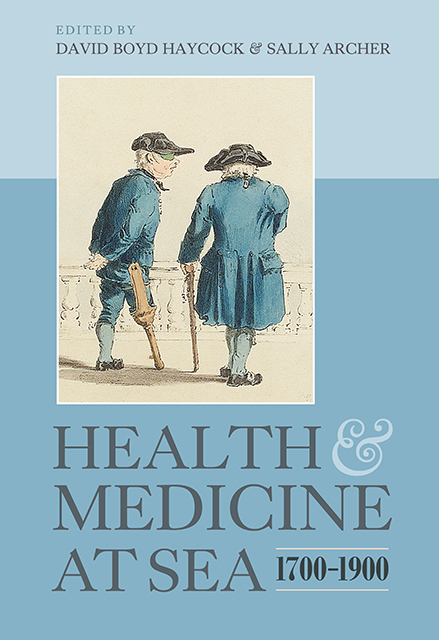Book contents
- Frontmatter
- Contents
- List of Figures and Tables
- Preface
- List of Contributors
- Acknowledgements
- List of Abbreviations
- Introduction Health, Medicine and the Maritime World: A History of Two Centuries
- 1 ‘The Intention is Certain Noble’: The Western Squadron, Medical Trials, and the Sick and Hurt Board during the Seven Years War (1756–63)
- 2 Royal Navy Surgeons, 1793–1815: A Collective Biography
- 3 Surgery in the Royal Navy during the Republican and Napoleonic Wars (1793–1815)
- 4 The Sick and Hurt Board: Fit for Purpose?
- 5 An ‘Important and Truly National Subject’: The West Africa Service and the Health of the Royal Navy in the Mid Nineteenth Century
- 6 Mortality and Migration: A Survey 128
- 7 Slave Purchasing Strategies and Shipboard Mortality: Day-to-Day Evidence from the Dutch African Trade, 1751–1797
- 8 Ships, Families and Surgeons: Migrant Voyages to Australia in the Age of Sail
- 9 Medical Encounters on the Kala Pani: Regulation and Resistance in the Passages of Indentured Indian Migrants, 1834–1900
- Bibliography
- Index
8 - Ships, Families and Surgeons: Migrant Voyages to Australia in the Age of Sail
Published online by Cambridge University Press: 07 March 2023
- Frontmatter
- Contents
- List of Figures and Tables
- Preface
- List of Contributors
- Acknowledgements
- List of Abbreviations
- Introduction Health, Medicine and the Maritime World: A History of Two Centuries
- 1 ‘The Intention is Certain Noble’: The Western Squadron, Medical Trials, and the Sick and Hurt Board during the Seven Years War (1756–63)
- 2 Royal Navy Surgeons, 1793–1815: A Collective Biography
- 3 Surgery in the Royal Navy during the Republican and Napoleonic Wars (1793–1815)
- 4 The Sick and Hurt Board: Fit for Purpose?
- 5 An ‘Important and Truly National Subject’: The West Africa Service and the Health of the Royal Navy in the Mid Nineteenth Century
- 6 Mortality and Migration: A Survey 128
- 7 Slave Purchasing Strategies and Shipboard Mortality: Day-to-Day Evidence from the Dutch African Trade, 1751–1797
- 8 Ships, Families and Surgeons: Migrant Voyages to Australia in the Age of Sail
- 9 Medical Encounters on the Kala Pani: Regulation and Resistance in the Passages of Indentured Indian Migrants, 1834–1900
- Bibliography
- Index
Summary
Introduction
In the first decades of the nineteenth century, the newly formed colonies of Australia eagerly sought immigrants to exploit their rich natural resources, and looked to the mother country for their recruits. The importation of labour from the northern hemisphere required considerable sums of money, however. From 1831, each of Australia's colonial governments funded immigration from the sale of land to well-off settlers, the proceeds of which were earmarked for recruiting suitably qualified emigrants from Scotland, Ireland, England and Wales. The occupations in greatest demand in Australia were shepherds, herdsmen, agricultural labourers, rural tradesmen such as fencers, ditchers, well-diggers, carpenters and stonemasons, farm and domestic servants, and so forth. Families with older children were preferred because the children represented future labour, and married couples were thought to be more stable entrants into the labour market. Between 1831 and 1900, 750,000 such emigrants, assisted by Australia's colonial governments, arrived on its shores.
Safely conveying these emigrants to the Antipodes was a challenging undertaking. The distance by sea from Britain to Australia spans twelve to fourteen thousand miles, depending on the route – usually a non-stop passage that would take from three to five months in the nineteenth century. The average time spent at sea for the non-stop voyage was around a hundred days from the mid 1840s, although some record-breaking voyages spent as little as seventy-seven days at sea, using the extreme Great Circle route. In addition to the length of the journey were the terrifying seas of the Southern Ocean, and the dangers of the rapid spread of disease amongst passengers confined in very close quarters. Nevertheless, the relatively few voyages that suffered high mortality due to violent epidemics, as well as the surprisingly few shipwrecks that occurred, have arguably attracted disproportionate attention, serving to characterize Australia's immigrants in the age of sail as victims of perilous voyages. In reality, the intervention of the state (following a small number of fatal voyages) – through careful regulation of migrant voyages, including the provision of surgeons on board – meant that emigrant families were given the best possible chance of a healthy, safe passage.
- Type
- Chapter
- Information
- Health and Medicine at Sea, 1700-1900 , pp. 172 - 194Publisher: Boydell & BrewerPrint publication year: 2009

